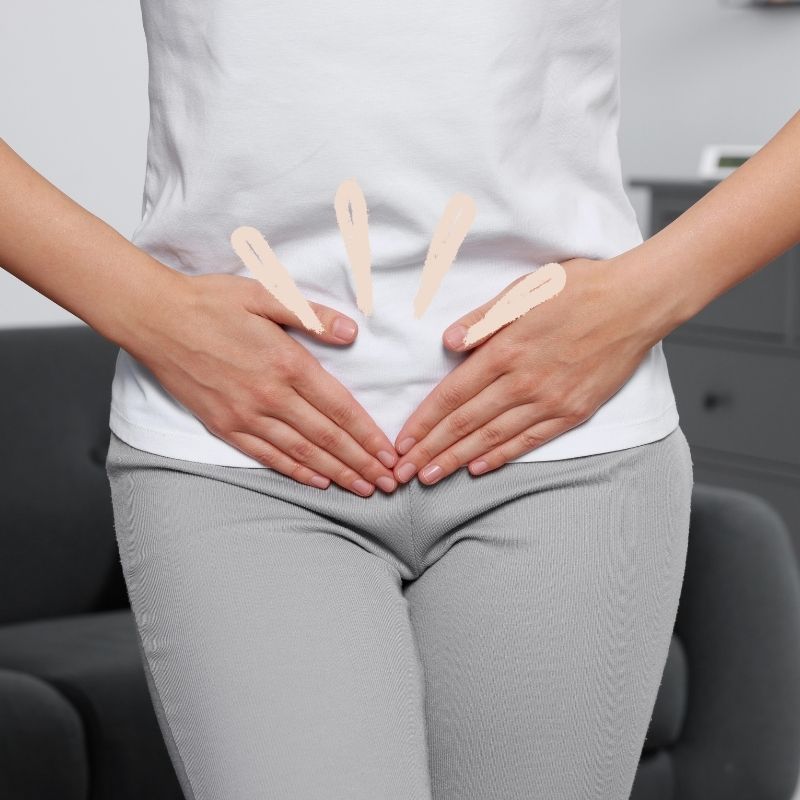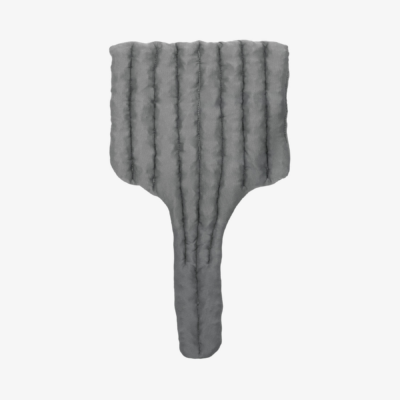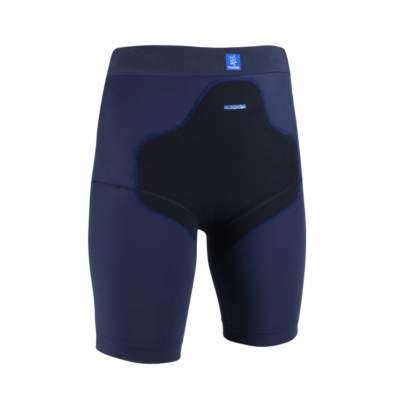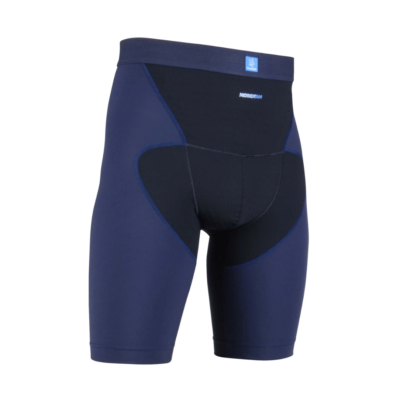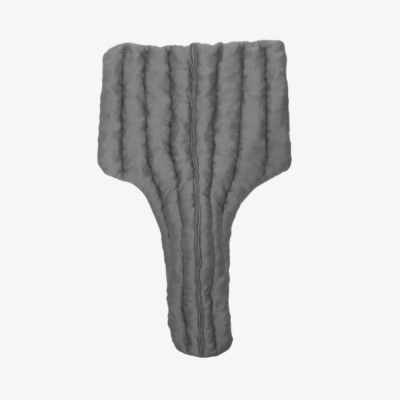Pelvic swelling and genital lymphedema affect more people than you might realize.
Unfortunately, many individuals struggle with these symptoms in silence, often avoiding conversations with their healthcare providers about such a sensitive topic.
But genital lymphedema can develop in both women and men at any age, usually after an injury or surgery.
As a licensed physical therapist who has specialized in lymphedema treatment for over 12 years, I’ve seen how isolating this condition can feel. In my practice, I’ve worked with hundreds of patients dealing with various forms of lymphedema, and I’ve noticed that those with genital lymphedema often wait the longest to seek help due to embarrassment.
However, when we address genital lymphedema with the same clinical attention we give to arm or leg swelling, people can often see significant improvements in their symptoms and quality of life.
What Is Genital Lymphedema?
Genital lymphedema occurs when lymph fluid accumulates in the tissues of the pelvic region, including the external genitalia, perineum, and surrounding areas. This chronic swelling develops when your lymphatic system can’t properly drain fluid from these delicate tissues.
Many people with genital lymphedema experience embarrassing symptoms that interfere with daily activities and intimate relationships.
Genital lymphedema also affects bladder function and causes the compromised skin to become vulnerable to breakdowns, wounds, and recurrent infections like cellulitis.
Like lymphedema in other parts of the body, genital lymphedema falls into two main categories:
- Primary Lymphedema: Develops from an inherent problem with lymphatic development, and the swelling can be present at birth or develop later in life.
- Secondary Lymphedema: Occurs after damage to the lymphatic system from medical treatments, infections, trauma, or surgical procedures in the pelvic region.
Genital lymphedema is rare, accounting for less than 1% of all lymphedema cases worldwide, but it can affect anyone.
What I’ve learned through years of treating this condition is that early intervention makes an enormous difference in outcomes. If you live with swelling in the pelvic region, it’s very important to have proper support and specialized care for lymphedema management.
What Causes Genital Lymphedema?
There are a few different things that can damage your lymph system in the pelvic region and lead to genital lymphedema. Most of the time, the condition develops because of an injury or surgical treatment.
In my clinical experience, I’ve observed that the genital soft tissues are especially susceptible because they’re naturally more elastic and can expand significantly when fluid accumulates. Gravity also plays a role, as lymph fluid tends to pool in lower areas of the body when there’s compromised drainage.
Common causes of genital lymphedema include:
- Cancer Treatments: Surgical removal of lymph nodes in the pelvis, groin, or abdomen during procedures for gynecological, prostate, bladder, or colorectal cancers.
- Radiation Therapy: Treatment in the pelvic area can damage lymphatic vessels and nodes.
- Gynecological Surgeries: Hysterectomies, ovarian procedures, or surgeries for endometriosis that affect pelvic lymph nodes.
- Prostate Surgery: Radical prostatectomy and lymph node dissection for prostate cancer treatment.
- Colorectal Procedures: Operations involving the rectum or colon that require lymph node removal.
- Infections: Severe pelvic infections, sexually transmitted infections (STIs), or cellulitis that damages lymphatic structures.
- Traumatic Injuries: Accidents or injuries that harm the pelvic lymphatic system.
- Inflammatory Conditions: Crohn’s disease, pelvic inflammatory disease, or other chronic inflammatory disorders.
- Obesity: Excess weight can strain the lymphatic system and impair drainage.
Outside of the US, lymphatic filariasis, a parasitic infection transmitted by mosquitoes, is one of the most common causes of scrotal lymphedema.
One pattern I’ve noticed in my practice is that patients who are aware of their lymphedema risk and monitor for early symptoms tend to have much better outcomes.
If you’re at risk for developing genital lymphedema, it’s important to watch out for lymphedema symptoms and even minor swelling.
When caught in its early stages, lymphedema can often be effectively managed or even reversed. But the longer it’s left untreated, the harder it becomes to get the swelling under control.
Genital Lymphedema Symptoms
Genital lymphedema symptoms can develop gradually or appear suddenly, depending on the underlying cause. The swelling may start as mild puffiness that comes and goes, but often progresses to persistent, uncomfortable enlargement that interferes with daily life.
People with genital lymphedema commonly experience:
- Visible swelling of the genitals, perineum, or surrounding areas
- Heavy, tight, or uncomfortable feelings in the pelvic region
- Skin that becomes thicker and harder to the touch
- Pain or discomfort that worsens with sitting, walking, or activity
- Difficulty with clothing fit and personal hygiene
- Skin changes like increased sensitivity, itching, or burning
- Infections, rashes, and slow-healing wounds
- Bladder symptoms, like having to urinate frequently
- Sexual dysfunction due to physical discomfort and appearance changes
Contact your healthcare team immediately if you experience sudden, significant swelling, signs of infection (redness, warmth, fever), or any non-healing wounds. The compromised skin barrier also makes the area vulnerable to complications, such as recurring infections.
Genital Lymphedema Male
In men, genital lymphedema typically affects external male genital organs, the scrotum (scrotal lymphedema), and the surrounding groin area.
Scrotal swelling is often the most noticeable symptom, and it can make walking uncomfortable and interfere with normal sitting.
I’ve worked with many male patients who feel self-conscious about the visible changes and struggle with the practical aspects of managing enlarged genital tissue in daily activities. Male genital lymphedema can also cause erectile dysfunction and/or altered sensation.
Genital Lymphedema Female
In women, genital lymphedema can affect the vulva, labia, and perineal area. The swelling is often asymmetrical and can cause changes in appearance that create both physical and emotional challenges.
The labia may swell and hang down, causing discomfort when walking or sitting. There’s also a higher risk of yeast infections and bacterial overgrowth.
In my experience treating female patients with genital lymphedema, I’ve learned that women often struggle with the intimate nature of these symptoms and may delay seeking treatment due to embarrassment or difficulty finding knowledgeable healthcare providers.
This is why education and creating a comfortable, clinical environment for discussion are so important.
Is Genital Lymphedema Contagious?
No, genital lymphedema isn’t contagious. You can’t catch it from someone else or pass it to another person through any type of contact, including sexual contact. Genital lymphedema is not a sexually transmitted disease (STD) or sexually transmitted infection (STI).
Is Genital Lymphedema Dangerous?
Genital lymphedema isn’t life-threatening, but it can lead to serious complications if left untreated. The main dangers associated with genital lymphedema include:
- Cellulitis: A serious bacterial infection that can spread quickly and require immediate antibiotic treatment.
- Recurrent Infections: Yeast infections, bacterial overgrowth, and urinary tract infections that keep coming back.
- Non-Healing Wounds: Open sores or skin breakdown that won’t heal due to poor circulation.
- Mental Health Problems: Depression, anxiety, and social isolation from the physical and emotional challenges.
What I consistently see in my practice is that early lymphedema treatment and proper management can prevent most of these complications.
Research shows that lymphedema has a normal life expectancy, and a good treatment plan can significantly reduce swelling so you can live a full, enjoyable life.
Can Genital Lymphedema Go Away?
No, genital lymphedema won’t just go away by itself. It’s a chronic condition.
However, with the right treatment, many people get much better. In my years of practice, I’ve seen that in the early stages, you can sometimes significantly reduce the swelling (although the underlying damage to your lymphatic system is still there).
For people who have had it longer or have more swelling, lymphedema usually won’t disappear entirely. But good treatment can make the swelling much smaller, stop it from getting worse, and help you feel comfortable again.
Genital Lymphedema Treatment
With proper management and physical therapy, genital lymphedema symptoms can improve and become much easier to live with.
As a certified lymphedema therapist, I’ve found that the most effective approach combines several treatment methods tailored to each individual’s specific needs.
The main forms of treatment are compression therapy, manual lymphatic drainage, and physical exercises. However, there are other important parts to managing lymphedema, such as skin care.
The goal of treatment is to reduce swelling, prevent it from getting worse, and help you feel more comfortable in your daily life. Most people need a combination of different treatments to get the best results. In extreme cases, you may also consider surgical management for genital lymphedema.
Compression Therapy
Compression therapy uses specially designed garments or bandages to apply gentle, steady pressure to the swollen area. This pressure helps push lymph fluid out of the tissues and back into the healthy parts of your lymphatic system.
For genital lymphedema, compression garments typically include special underwear, shorts, or custom-fitted garments that provide support without being too tight or uncomfortable.
The patients who see the most improvement in my practice are those who wear compression garments consistently, especially during the day when they’re active. This can make a big difference in controlling swelling.
Here are my favorite compression garments for genital lymphedema:
Manual Lymphatic Drainage (MLD)
Manual lymphatic drainage is a special type of gentle massage that helps move lymph fluid to healthy lymph nodes so that they can drain it properly. The massage uses very light pressure and movements to encourage fluid to flow in the right direction.
A certified lymphedema therapist can show you how to do MLD for genital lymphedema.
You can learn to do it at home, focusing on moving fluid from your genital area toward the lymph nodes in the front of your hips and groin. You can do MLD every day or as often as needed.
Exercise
Physical exercise helps your lymphatic system work better by activating your muscles, which act like pumps to move lymph fluid through your body.
Virtually any form of exercise is beneficial for genital lymphedema, including walking, swimming, gentle stretching, and specific lymphatic exercises that target the pelvic area.
What I’ve observed consistently in my clinic is that patients who find a form of exercise they enjoy and can stick to doing regularly see the best long-term results. You don’t need to do intense workouts, but you do need to be consistent and move your body regularly. For example, try these vibration plate exercises or rebounder workouts.
Other Treatment Options
There are a few other things that can help you manage genital lymphedema symptoms:
- Deep breathing helps create pressure changes in your body that naturally move lymph fluid. Taking slow, deep breaths for just a few minutes a few times a day can make a difference.
- Kinesiology tape is a special elastic tape that can provide gentle support and help with lymph drainage, especially in the early stages or with mild swelling.
- Pneumatic pumps are machines that use gentle air pressure to massage swollen areas and move fluid. These devices require a prescription and training on how to use them safely.
- Genital lymphedema surgery may be an option for severe cases that don’t respond well to other treatments. Surgery can remove excess tissue or create new drainage pathways.
Also, skin care is crucial for preventing infections and keeping your skin healthy. This includes gentle cleansing, moisturizing, and watching for any signs of infection or skin breakdown.
Are There Doctors Who Treat Genital Lymphedema?
Yes, the best person to see is a certified lymphedema therapist (CLT).
Certified lymphedema therapists are trained in the most effective treatments for all types of lymphedema, including genital lymphedema. They can teach you proper techniques for manual lymphatic drainage, help you find the right compression garments, and create a treatment plan.
While I specialize in the physical management of lymphedema, some patients also benefit from working with counselors or support groups to address the emotional aspects of living with this condition – and that’s perfectly normal.
To find a certified lymphedema therapist near you, ask your doctor for a referral or search online directories like the Lymphology Association of North America.
How to Avoid Lymphedema After Groin Lymph Node Removal?
If you’ve had groin lymph nodes removed or damaged during surgery, there are steps you can take to lower your risk of developing genital lymphedema. While there’s no guarantee you can prevent it completely, these precautions can make a big difference.
- Protect the area from injury: Be gentle with the skin around your groin and genitals. Avoid tight clothing that rubs or cuts into your skin, and be careful during activities that might cause cuts or scrapes.
Watch for early signs: Learn what early lymphedema looks like so you can get treatment quickly if swelling starts. Look for feelings of heaviness, tightness, or any visible swelling, even if it’s small.
Keep your skin healthy: Clean the area gently every day and keep your skin moisturized. Watch for any signs of infection, like redness, warmth, or unusual pain.
Stay active: Gentle exercise helps your lymphatic system work better. Walking, swimming, and stretching are all good choices. Avoid sitting or lying down for long periods without moving.
Maintain a healthy weight: Extra weight puts more strain on your lymphatic system and can increase your risk of developing lymphedema.
In my practice, I educate all at-risk patients on these preventive measures because I’ve seen how much more manageable lymphedema is when caught early.
Your healthcare team should educate you on your specific risk level and what precautions make the most sense for you.
FAQs
What does genital lymphedema look like?
Genital lymphedema causes visible swelling that can range from mild puffiness to a big enlargement of the genital area. In men, the scrotum often becomes enlarged and may hang lower than normal. The penis might appear buried or shortened due to surrounding swelling. In women, the labia can become significantly swollen and may hang down, and the entire vulvar area might look puffy or enlarged.
The skin often looks stretched and may feel thicker or harder than normal. The swelling usually doesn’t go away with rest or elevation, and it may get worse throughout the day or with activity.
How to drain lymphatic fluid from the groin?
The best ways to drain fluid buildup from the groin area include compression therapy (wearing a compression garment, like shorts), manual lymphatic drainage (MLD), and physical exercise. Most people living with genital lymphedema combine a few different forms of treatment for the most effective lymphatic drainage. It’s important to experiment and see what works best for you.
What can be mistaken for lymphedema?
A few different conditions can cause genital swelling that looks like lymphedema, including lipedema (a condition where fat cells enlarge and cause swelling, usually in the legs but sometimes affecting the genital area) and general obesity that creates excess tissue in the pelvic region. It’s also possible for doctors to sometimes misdiagnose genital lymphedema. If you have swelling in the genital area but can’t get a clear diagnosis, consider seeing a different provider.
What is the surgery for genital lymphedema?
Surgery for genital lymphedema is usually considered only when other treatments haven’t worked and the swelling is severe.
There are several types of procedures, including debulking surgery, which removes excess tissue and skin to reduce the size of swollen areas. Lymphaticovenular anastomosis creates new connections between lymphatic vessels and small veins to help drain fluid better. Vascularized lymph node transfer moves healthy lymph nodes from another part of your body to the affected area to improve drainage.
These surgeries require specialized surgeons and have risks, so they’re typically reserved for the most severe cases where quality of life is significantly affected and conservative treatments haven’t provided enough relief.
What exercises are good for genital lymphedema?
The best exercises for genital lymphedema are gentle activities that you can consistently include in your routine. Walking, swimming, gentle stretching, strength training, yoga, and even newer forms of exercise, like vibration plates or rebounder workouts, are all great options. Pelvic floor exercises can also be helpful. Virtually any form of movement and exercise is beneficial, but it’s important to do them consistently, ideally every day, for the best lymphatic drainage benefits.
Get Support for Genital Lymphedema in Lower Body Lymphedema Rehab
Living with genital lymphedema can feel isolating and overwhelming, and it’s often hard to find high-quality support and education on how to manage your symptoms.
As a certified lymphedema therapist (CLT-LANA), with over 12 years of experience, I’ve seen many people struggle with swelling for years before they saw a physical therapist. This is why I created my program, Lower Body Lymphedema Rehab.
Inside Lower Body Lymphedema Rehab, you’ll find exercises, self-care techniques, and recommendations that have helped thousands of my patients in the physical therapy clinic.







